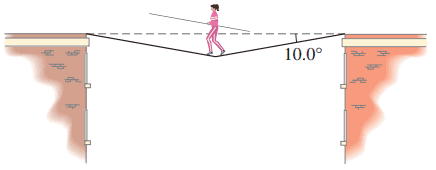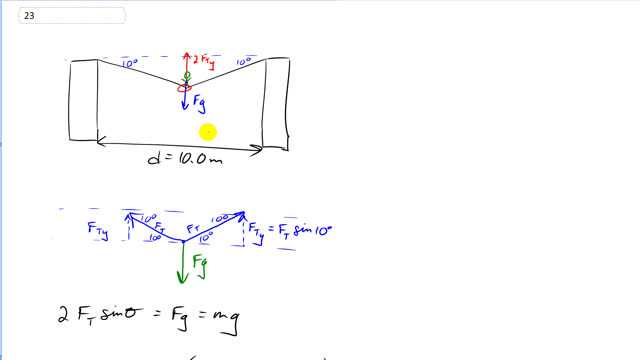
Arlene is to walk across a “high wire” strung horizontally between two buildings 10.0 m apart. The sag in the rope when she is at the midpoint is , as shown in Fig. 4–47. If her mass is 50.0 kg, what is the tension in the rope at this point?


In order to watch this solution you need to have a subscription.
This is Giancoli Answers with Mr. Dychko. The force upwards on our lien the tightrope walker has to equal the force downwards so, the force down is obviously gravity and equal to mg but the force up is a little bit, takes bit more thought to figure out how to calculate that. And there's a constant tension along the high wire, and because of this angle, 10 degrees below horizontal, this tension has a certain component that's vertical upwards, FTy, and that equals the tension force, Ft, times sine of 10 degrees. We're using some parallel line rules here. So, this angle here is 10 degrees we're told and this dotted line is parallel to this horizontal. And this 10 degrees in here is an anterior opposite angle to this one, and so it's equal. So, that's how we know this one here is 10 degrees. And this being the opposite leg of this triangle, that's how we know we're using sine of 10 degrees to calculate it cause sine is opposite over hypotenuse. And that's happening twice. This triangle here, you can also see that there's a force of tension in the Y direction upwards. So, it's 2 times Ft sine theta equals Fg. And Fg is mg. So, knowing that, by the way this 10 meter separation between the towers was irrelevant, didn't need to know that. So, we can solve for Ft here by dividing both sides by 2 times sine theta. Then we have the tension forces, the weight, 50 kilograms times 9.8 Newtons per kilogram divided by 2 times sine of 10 degrees which is 1.41 times to the 3 Newtons must be the tension force in the high wire.
So i have imputed (50)(9.80) divided by (2sin(10)) and I am not getting the same answer you are getting
Hi micisner,
I just double checked the answer, and it still works out to . If I had to guess where your mistake is, maybe your calculator needs to be in "degree" mode rather than "radian" mode? Otherwise maybe there's a mistake with brackets in the denominator and your calculation ends up multiplying by instead of dividing?
Let me know how it goes,
Mr. Dychko
You were totally right! My calculator was in radian. Thank you so much for your help.
Best,
Micisner
@micisner, my pleasure, and it's great there is an easy fix!